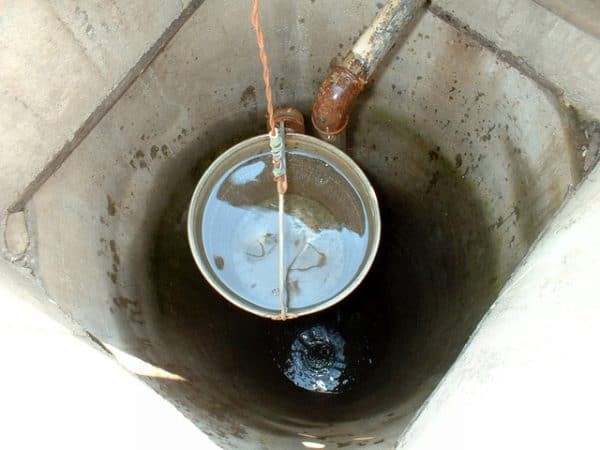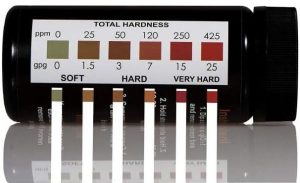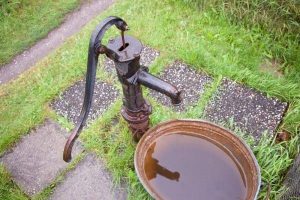What Is Well Water?
Well water is basically water located deep in the ground. A hole was dug deep in the ground until it reaches the aquifer, a layer of permeable rock that holds water.
Upon establishing a connection with the aquifer, a pump like the shallow well water pump will be installed to extract the water into the well for the residents.
As such, well water is often not tested or treated by the govternment.
Recent statistics stated that 13 percent of Americans rely on household wells for their water needs. That comes out to around 42 million Americans.
What Are The Types Of Wells?
The Environmental Protection Agency (EPA) notes that there are three general types of wells. They vary in terms of their depth and how they are created.
- Bored or Dug Wells
- Driven Wells
- Drilled Wells

Bored or Dug Wells
Bored or dug well are created by using a shovel or a more high-powered piece of equipment such as a backhoe. The dug wells are then lined with some bricks, stones, or tiles to reinforce them.
A dug well is not very deep. It ranges in depth from around 10 to 30 feet.
Driven Wells
To create a driven well, workers will use a pipe to reach deep into the ground. The pipe will be driven down until it reaches some aquifers to draw water from.
Driven wells can be around 30 to 50 feet deep.
Drilled Wells
More powerful tools are required to create drilled wells. Usually, rotary drilling machines are called on for that job. Drilled wells also have to be reinforced well because of how deep they go.
You can find drilled wells that go thousands of feet deep.
Problems Associated To Well Water
Even if the private wells homeowners use are lined with plenty of materials to protect them from their surroundings, the water itself can still end up housing plenty of substances.
Water in that condition can present some problems when used in and around your home.
- Well water can cause staining
- Appliances broke down faster
- Play Host To Contaminants
Staining
Have you ever experience a rusty and stained toilet bowl? The high iron and rust in your well water are making your appliance feeling rusty.
This is a common problem for well water users and it could potentially clog the pipe for water-based appliances.
Appliances Broke Down Faster
Since well water can end up being exposed to soil and the minerals that contain, you can easily end up with hard water flowing into your home.
Hard water may not pose much of a threat to your health, but it can stain your fixtures, dishes, glasses, and several other household items.
Susceptible To Water-Borne Disease
Well water does not undergo treatment from the government and is often extracted from deep beneath the ground.
Often kept unclosed and constantly in contact with the ground, some water-borne diseases could contaminate the water.
Is It Safe To Drink Well Water?
Safety should always be your primary concern when it comes to using any kind of water. Unfortunately, it is difficult to say right away if your well water is safe for drinking.
Natural chemicals present in the soil can pose a legitimate threat to your health.
On top of that, your home well can also be an attractive spot for microorganisms. Remember that certain microorganisms such as bacteria thrive in moist, protein-rich environments. A private well could very well turn into a breeding ground for bacteria if left unchecked.
Factors such as the depth of the well, the wall linings used to protect the water, and where it’s located can also affect water quality.
To be absolutely certain about the quality of the well water, homeowners are urged to send water samples for regular laboratory testing.
Common Well Water Contaminants

Different kinds of contaminants can end up in the well water supply. Some of the most notable examples are included below:
Fluoride
Many private wells rely on aquifers to provide their users with water. Aquifers just so happen to be good sources of fluoride.
A small amount of fluoride in the water can be beneficial to people, but if too much of it is consumed, problems can emerge. Among the conditions that can stem from the excessive intake of fluoride are teeth discoloration, dental fluorosis, and skeletal fluorosis.
Heavy Metals
Heavy metals can wind up in the well water supply due to how the water itself moves through the ground. Run-offs can also cause heavy metals to drop into the water.
Examples of heavy metals you may find if you use well water are chromium, copper, and lead. Consume enough of those heavy metals and you could develop serious diseases related to your liver and/or kidneys.
Microorganisms
Bacteria are not the only microorganisms you need to worry about if you are relying on well water. You will also have to worry about parasites and viruses.
Among the leading reasons why microorganisms are in your well water could be a nearby storage tank that recently sprung a leak.
Be wary of microorganisms because they can cause all kinds of problems, especially ones that affect your digestive system.
Nitrate and Nitrite
Nitrate and nitrite are not substances to worry too much about if the only people using the well water inside your home are older children and adults.
Infants are another matter altogether as the aforementioned substances can lead to them developing methemoglobinemia, a condition more widely known as “blue baby syndrome.”
Nitrate and nitrite can enter your well water supply in the same ways that heavy metals do.
Organic Chemicals
We encounter organic chemicals on a regular basis. They often come in the form of disinfectants, petroleum products, and pharmaceuticals. The ink in the pen you’re using is also considered an organic chemical.
Organic chemicals that manage to infiltrate your well water supply via spills and leakages can be problematic to your liver and kidneys.
Radionuclides
Radionuclides are not as prevalent as the other contaminants, but there are areas where they are already present in the soil.
More often than not though, radionuclides are abundant in areas where coal or uranium mining is taking place.
You need to take radionuclides seriously as they can be very damaging to your kidneys and even lead to the development of deadly diseases such as cancer.
Well Water Tests
When sending your well water in for testing, it’s important to have the substance tested in different ways to determine its quality more accurately.

Here are the tests that need to be conducted:
- Basic Water Potability
- Coliform Bacteria
- Dissolved Solids
- Fluoride
- Irons
- Nitrate
- Sulphate
- Other substances
Basic Water Potability
Arguably the most important test you can have run on your well water and one that will tell you about the levels of substances such as chloride, coliform bacteria, dissolved solids, fluoride, iron, manganese, nitrates, pH level, sodium, sulfate, and water hardness. This test will also let you know if you need to run additional examinations for specific contaminants.
Coliform Bacteria
Check on these because they can cause illnesses.
Dissolved Solids
The dissolved solids in the water can affect its flavor.
Fluoride Test
This can be good for your teeth in small doses, but problematic when too much of it is in your water supply.
Irons Test
If your water tastes or smells strange, it probably has something to do with the iron content.
Nitrate Test
Run an additional check for nitrates if you have an infant at home because that substance can be lethal to them.
Sulfate
Too much sulfate in the water can cause digestive problems.
Other Substances
Test for other substances such as arsenic and uranium as they can be harmful in the water.
How Often Should I Test My Well Water?
Testing your well water is important not just to see if there are contaminants in it.
The testing is also necessary to see if the water quality has remained consistent or if there are parts of your treatment system that need to be improved.
At a minimum, well water should be tested once a year, but seasonal testing is ideal.
Well Water Vs. City Water
We now understand plenty about well water, but what about city water? Are they any different from one another or are they just the same thing?
City Water
City water is often referred to as tap water. The government, via the public water system, is in charge of treating city water while the EPA sets the standards the substance must adhere to.
Let’s Compare
City water also varies from well water in a few ways.
| Comparison | Well Water | City Water |
| Drinkability | Not advisable to drink unfiltered | Drink Directly From The Tap |
| Test and Treatment | Self-test and treatment | Treated by government |
| Quality Check | Constant monitor by the well owner | Constant monitor by government |
Drinkability
For city water, you can drink water straight from the tap and experience no health problems from doing so. You may not have the same experience if you drink well water that was not tested and treated beforehand.
Test And Treatment
The government is the one in charge of testing and treating the supply of tap water coming into your home. If you decide to use well water, you will have to handle those things yourself.
Quality Check
With the government keeping a close eye on the city water supply, you don’t have to constantly watch over its quality. Well water has to be tested at least once a year and even more often than that in some cases.
Recap
Well water can seem like a fine alternative to tap water, especially since you no longer need to rely on the government for your supply.
However, there are serious risks related to using well water and you need to take them into account before deciding if you will be better off relying on that kind of water source.
